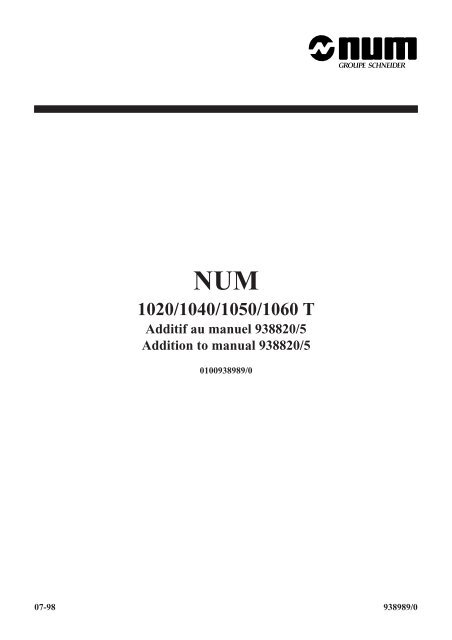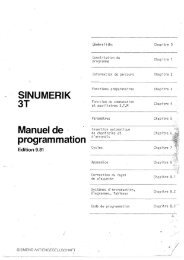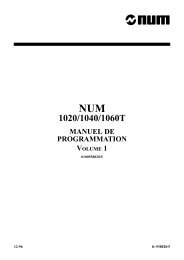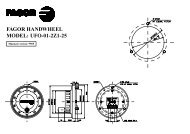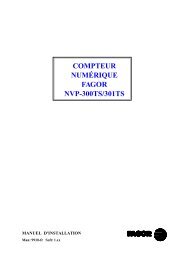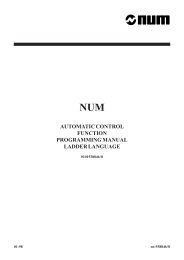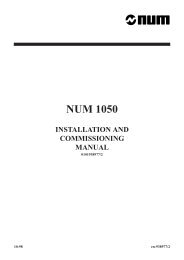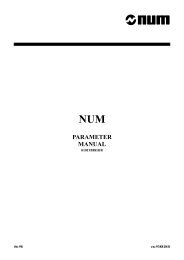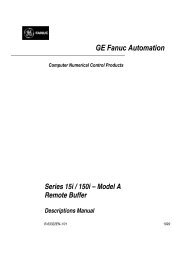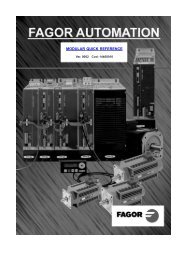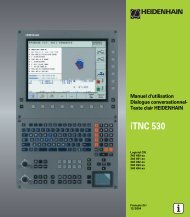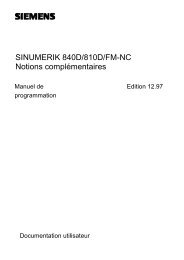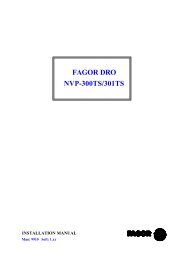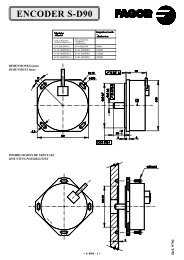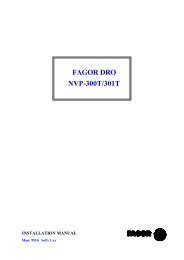Additif au manuel T
Additif au manuel T
Additif au manuel T
You also want an ePaper? Increase the reach of your titles
YUMPU automatically turns print PDFs into web optimized ePapers that Google loves.
NUM<br />
1020/1040/1050/1060 T<br />
<strong>Additif</strong> <strong>au</strong> <strong>manuel</strong> 938820/5<br />
Addition to manual 938820/5<br />
0100938989/0<br />
07-98 938989/0
Despite the care taken in the preparation of this document, NUM cannot guarantee the accuracy of the information it contains and cannot be<br />
held responsible for any errors therein, nor for any damage which might result from the use or application of the document.<br />
The physical, technical and functional characteristics of the hardware and software products and the services described in this document are<br />
subject to modification and cannot under any circumstances be regarded as contractual.<br />
The programming examples described in this manual are intended for guidance only. They must be specially adapted before they can be used<br />
in programs with an industrial application, according to the <strong>au</strong>tomated system used and the safety levels required.<br />
© Copyright NUM 1998.<br />
All rights reserved. No part of this manual may be copied or reproduced in any form or by any means whatsoever, including photographic or<br />
magnetic processes. The transcription on an electronic machine of all or part of the contents is forbidden.<br />
© Copyright NUM 1998 software CNC NUM 1000 family.<br />
This software is the property of NUM. Each memorized copy of this software sold confers upon the purchaser a non-exclusive licence strictly<br />
limited to the use of the said copy. No copy or other form of duplication of this product is <strong>au</strong>thorized.<br />
2 938989/0
<strong>Additif</strong> <strong>au</strong> <strong>manuel</strong> de Programmation T - 938820/5<br />
1 Evolutions tar<strong>au</strong>dage rigide 5<br />
1.1 Rappel : Cycle de tar<strong>au</strong>dage rigide : G84 5<br />
1.2 Programmation du cycle 5<br />
1.3 Arrêt du cycle de tar<strong>au</strong>dage rigide 5<br />
1.4 Autres évolutions et corrections 6<br />
2 Détar<strong>au</strong>dage rigide 7<br />
2.1 Description fonctionnelle 7<br />
2.1.1 Utilisation 7<br />
2.1.2 Programmation du cycle 7<br />
2.1.3 Erreurs détectables 8<br />
2.1.4 Exécution du cycle de détar<strong>au</strong>dage rigide 8<br />
2.1.5 Conditions particulières pour sortir les outils<br />
"à vue" 8<br />
3 Evolution synchronisation des broches 9<br />
3.1 Description fonctionnelle du logiciel 9<br />
3.1.1 Accélération fonction vitesse 9<br />
3.2 Synchronisation de broches avec maître piloté<br />
en vitesse 10<br />
3.2.1 Correcteur à action intégrale 10<br />
3.2.2 Correcteur à avance de phase variable 11<br />
3.3 Interface Homme - Machine 12<br />
3.4 Principe d'utilisation du produit logiciel 13<br />
3.4.1 Procédure de réglage 13<br />
3.4.2 Programmation de la synchronisation de<br />
broches 13<br />
3.5 Liste des paramètres E relatifs <strong>au</strong>x broches 16<br />
4 Reprise de filetage 18<br />
4.1 Généralités 18<br />
4.2 Programmation 18<br />
4.3 Contraintes 19<br />
4.4 Intégration de la fonction G38+ dans le cycle<br />
G33 19<br />
4.4.1 Syntaxe de la reprise _filetage dans l'appel du<br />
cycle G33 19<br />
5 Evolution et mises à jour diverses 20<br />
5.1 Création des fichiers CN 20<br />
5.2 Chapitre 6.5 "Affichage d'un message avec<br />
réponse de l'opérateur" 20<br />
5.3 Cycle de prise d'origine <strong>au</strong>tomatique 20<br />
5.3.1 Mode POM 20<br />
5.3.2 Appel par fonction G159 : Mode CONT (ou IMD) 22<br />
5.3.3 Axes synchronisés par paramètres machine 23<br />
5.3.4 Commutation broche/axe C en DISC NT 23<br />
938989/0 3
4 938989/0<br />
Addition to T Programming manual - 938820/5<br />
1 Changes to Rigid Tapping 25<br />
1.1 Review: Rigid Tapping Cycle: G84 25<br />
1.2 Programming the Cycle 25<br />
1.3 Stopping the Rigid Tapping Cycle 25<br />
1.4 Other Changes and Corrections 26<br />
2 Rigid Tap Removal 27<br />
2.1 Functional Description 27<br />
2.1.1 Use 27<br />
2.1.2 Programming the Cycle 27<br />
2.1.3 Detectable Errors 28<br />
2.1.4 Execution of the Rigid Tap Removal Cycle 28<br />
2.1.5 Particular Conditions for Tap Removal on Sight 28<br />
3 Change in Spindle Synchronisation 29<br />
3.1 Functional Description of the Software 29<br />
3.1.1 Speed-Dependent Acceleration 29<br />
3.2 Spindle Synchronisation with Master Spindle<br />
Speed Control 30<br />
3.2.1 Corrector with Integral Action 30<br />
3.2.2 Corrector with Variable Phase Lead 31<br />
3.3 Man/Machine Interface 32<br />
3.4 Principle of Use of the Software Product 33<br />
3.4.1 Setting Procedure 33<br />
3.4.2 Programming Spindle Synchronisation 33<br />
3.5 List of Parameters E Relative to Spindles 36<br />
4 Resumption of Thread Cutting 38<br />
4.1 General 38<br />
4.2 Programming 38<br />
4.3 Constraints 39<br />
4.4 Inclusion of function G38+ in Cycle G33 39<br />
4.4.1 Syntax of Resumed Thread Cutting Included<br />
in the Call to Cycle G33 39<br />
5 Miscellaneous Changes and Updates 40<br />
5.1 Creation of CNC Files 40<br />
5.2 Section 6.5, Message display with wait<br />
operator response 40<br />
5.3 Automatic Homing Cycle 40<br />
5.3.1 Homing Mode 40<br />
5.3.2 Call by Function G159: AUTO (or MDI) Mode 42<br />
5.3.3 Axes Synchronised by Machine Parameters 43<br />
5.3.4 Spindle/C-axis switching in DISC NT 43
1 Evolutions tar<strong>au</strong>dage rigide<br />
1.1 Rappel : Cycle de tar<strong>au</strong>dage rigide : G84<br />
<strong>Additif</strong> <strong>au</strong> <strong>manuel</strong> de programmation T - 938820/5<br />
Le cycle permet d'asservir l'avance de l'outil à la rotation de la broche. La vitesse d'avance est calculée <strong>au</strong>tomatiquement<br />
selon la vitesse de la broche et le pas programmés.<br />
Le cycle permet la programmation de tar<strong>au</strong>dage suivant les axes X ou Z. La modulation des vitesses par potentiomètre<br />
n'est pas inhibée pendant l'exécution du cycle. Le potentiomètre "Broche" est toujours actif ; le potentiomètre "Avance"<br />
est sans effet pendant le tar<strong>au</strong>dage proprement dit ; il est actif durant les divers <strong>au</strong>tres positionnements.<br />
1.2 Programmation du cycle<br />
Le cycle G84 permet désormais de programmer ou non la fonction M05<br />
Par exemple : G84 Z-200 K1.25 EK2.5 M5<br />
Si la fonction M05 est programmée dans le cycle de tar<strong>au</strong>dage rigide, la broche sera arrêtée en fin de tar<strong>au</strong>dage.<br />
Si la fonction M05 n'est pas programmée dans le cycle de tar<strong>au</strong>dage rigide, la broche sera remise en rotation dans le<br />
sens initial.<br />
Les fonctions G84 peuvent désormais être programmées dans l'un des 8 groupes et utiliser l'une des 4 broches si elles<br />
sont conformes.<br />
Le reste du cycle de tar<strong>au</strong>dage rigide est sans changement.<br />
Exécution du cycle de tar<strong>au</strong>dage rigide<br />
Ce cycle est réalisé dans les mêmes conditions que précédemment.<br />
La broche doit être pilotée par le groupe où est programmé le cycle.<br />
En fin de G84, une fois la cote EH atteinte (retour à la cote du plan d'attaque sur l'axe d'usinage), si M5 est programmée<br />
dans le cycle, la broche sera mise dans l'état M5.<br />
En fin de tar<strong>au</strong>dage, Z est en h<strong>au</strong>t du trou :<br />
s'il y a inversion de broche<br />
La broche ralentit suivant E9033b (initialisé par P32 N48) jusqu'à l'arrêt... puis s'inverse.<br />
Les mouvements d'axes commencent dès que la broche tourne dans le bon sens.<br />
S'il y a arrêt de broche - M5 Programmé<br />
La broche ralentit suivant E9033b jusqu'à l'arrêt de la broche.<br />
Les mouvements des axes se font pendant la décélération broche.<br />
1.3 Arrêt du cycle de tar<strong>au</strong>dage rigide<br />
Si "Stop_broche" d'une broche, en cours de tar<strong>au</strong>dage rigide, passe à 1 (%W22.i =1 avec i ∈ [0..3]), celle-ci est arrêtée<br />
et par conséquent l'axe d'usinage est synchronisé.<br />
Si "Stop_broche" d'une broche, en cours de tar<strong>au</strong>dage rigide, repasse à 0 (%W22.i =0 avec i ∈ [0..3]), la broche est<br />
relancée et le tar<strong>au</strong>dage rigide reprend. La manipulation du "Stop_broche" est réservée <strong>au</strong> cas d'urgence.<br />
A l'arrêt de la broche, RAZ_CN peut alors être exécuté et le tar<strong>au</strong>dage rigide sera abandonné.<br />
Il est possible d'exécuter n'importe quelle fonction disponible dont un tar<strong>au</strong>dage rigide en mode CONT ou IMD.<br />
938989/0 5
1.4 Autres évolutions et corrections<br />
La nouvelle version du G84 permet d'effectuer un tar<strong>au</strong>dage rigide sur les systèmes <strong>au</strong> 1/10ème de µm.<br />
Les fonctions actionnant ou invalidant des transformations géométriques (inch/métrique, facteur d'échelle, PREF/DEC,<br />
etc ...) actives lors d'un cycle G84 (tar<strong>au</strong>dage rigide) sont prises en compte dans les conditions suivantes :<br />
- les cotes et le pas sont comptés dans l'unité active en pouce (inch) ou mm en G70 ou G71.<br />
- le facteur d'échelle s'il est valide s'applique à toutes les cotes programmées dans le cycle G84 (X..Z, ER et EH), mais<br />
il ne s'applique pas <strong>au</strong> pas (K) et à (EK).<br />
- la fonction miroir, sur l'axe outil, est incompatible avec G84 (tar<strong>au</strong>dage rigide).<br />
Ce comportement est <strong>au</strong>ssi celui de la fonction G39+ (détar<strong>au</strong>dage rigide).<br />
Jusqu'à la version L du logiciel, le tar<strong>au</strong>dage rigide (G84) en pouce (inch) ou en 1/10ème de µm entraînait les problèmes<br />
suivants :<br />
- lorsque l'unité était définie en pouce (inch), le pas K était divisé par 2,54,<br />
- lors du détar<strong>au</strong>dage, la vitesse de broche était <strong>au</strong>ssi divisée par 2,54,<br />
- le rapport EK était affiché sur page INFO multiplié par 10,<br />
- en 1/10 ème de µm : La vitesse de broche <strong>au</strong> détar<strong>au</strong>dage pouvait être limitée : par exemple : S60 G84 K1 EK2 ...<br />
provoquait un détar<strong>au</strong>dage à S100 (<strong>au</strong> lieu de S120).<br />
6 938989/0
2 Détar<strong>au</strong>dage rigide<br />
2.1 Description fonctionnelle<br />
<strong>Additif</strong> <strong>au</strong> <strong>manuel</strong> de programmation T - 938820/5<br />
2.1.1 Utilisation<br />
Circonstance de mise en œuvre : un incident est survenu en cours de tar<strong>au</strong>dage rigide. L'opérateur a dû, pour une raison<br />
impérieuse, interrompre le tar<strong>au</strong>dage rigide en cours et éventuellement couper la tension sur la CN : l'outil reste prisonnier<br />
de la matière.<br />
La fonctionnalité de détar<strong>au</strong>dage rigide permet désormais de commander plus aisément la sortie de l'outil hors de la<br />
matière ; y compris si la POM n'a pas pu être réalisée et si le plan incliné est valide.<br />
2.1.2 Programmation du cycle<br />
Syntaxe<br />
[M64 à M66] G39+ M3/M4 [M40 à M45] S.. K.. Z..<br />
avec :<br />
M64 M66 Si nécessaire fonctions permettant <strong>au</strong> groupe de commander la broche.<br />
G39+ Cycle de détar<strong>au</strong>dage rigide qui appelle 4 paramètres obligatoires<br />
et un paramètre optionnel programmés immédiatement derrière la fonction.<br />
M3 ou M4 Sens de rotation de la broche.<br />
M40 à M45 Choix de la gamme (Paramètre optionnel).<br />
S.. Vitesse de rotation de la broche.<br />
K.. Valeur du pas en mm.<br />
Z.. Axe et longueur signée du dégagement (en mm et en relatif).<br />
Les axes U à Z peuvent être programmés s'ils existent.<br />
Particularités<br />
Les arguments du cycles peuvent être remplacés par des paramètres E ou des variables L.<br />
Exemple 1 :<br />
G39+ M3 M41 S200 K1.2 W10<br />
Exemple 2 : si E80000 = 3 et E80001 = 42<br />
G39+ ME80000 ME80001 SL0 KL1 Z-10<br />
Les fonctions actionnant ou invalidant des transformations géométriques (inch/métrique, facteur d'échelle, PREF/DEC,<br />
etc...) actives lors du G39+ sont prises en compte dans les conditions suivantes :<br />
- les cotes et le pas sont comptés dans l'unité active pouce (inch) ou mm avec G70 ou G71,<br />
- le facteur d'échelle, s'il est valide, s'applique à la cote concernée, mais il ne s'applique pas <strong>au</strong> pas (K),<br />
- la fonction miroir est incompatible avec G39+.<br />
Ce comportement est identique à celui de la fonction G84 ( tar<strong>au</strong>dage rigide).<br />
On notera :<br />
- que le cycle G39+ force l'utilisation de la broche en G97.<br />
- que l'outil ne devant pas être programmé et le déplacement étant effectué en relatif, la cohérence de la direction d'outil<br />
n'est pas vérifiée.<br />
938989/0 7
2.1.3 Erreurs détectables<br />
Erreur 4 : si l'option 20 est absente<br />
Erreur 2 : si l'un des 4 arguments obligatoires (M3/M4 ou S ou K ou Z) n'a pas été programmé<br />
si un <strong>au</strong>tre argument a été programmé<br />
si une fonction M différente de [M3/M4 - M40 à M45]<br />
si S est trop grand (>65536)<br />
si K est négatif ou nul<br />
Erreur 1 : si l'axe programmé n'existe pas<br />
si plusieurs axes sont programmés ou un même axe plusieurs fois<br />
si M3/M4 ou M40 à M45 sont programmés deux fois<br />
si miroir est actif sur l'axe de tar<strong>au</strong>dage<br />
si la broche n'est pas en état M5<br />
Erreur 39 : si S n'est pas compatible avec la gamme programmée<br />
si on doit faire une recherche de gamme <strong>au</strong>tomatique alors que cela n'est pas <strong>au</strong>torisé [gamma non<br />
programmée et bit 7 de P7 N0 à 1]<br />
2.1.4 Exécution du cycle de détar<strong>au</strong>dage rigide<br />
Ce cycle peut être réalisé même si la POM sur l'axe et/ou la broche n'a pas été faite.<br />
Le plan incliné peut être actif.<br />
La broche doit être pilotée par le groupe où est programmé le cycle.<br />
Elle est en début de cycle dans l'état M5.<br />
Pour mise à l'échelle de la consigne de broche, on doit retrouver la gamme qui était enclenchée lors du tar<strong>au</strong>dage<br />
interrompu. Si nécessaire, la gamme sera reprogrammée dans le cycle G39+. Si la gamme n'est pas programmée, on<br />
fera l'équivalent d'une recherche de gamme <strong>au</strong>tomatique : la fonction ne sera pas transmise à l'<strong>au</strong>tomate.<br />
On n'exécutera pas les sous-programmes normalement appelés par les fonctions M3/M4 et M40 M45.<br />
En début de cycle, la broche est commandée dans le sens demandé avec la vitesse de broche minimum (P62 N1, N3,<br />
N5 ou N7). Puis la vitesse de broche est uniformément accélérée jusqu'à atteindre la vitesse S programmée.<br />
Dès le début du cycle, le mouvement de l'axe Z est asservi à la broche [G38] en minimisant l'erreur de poursuite de façon<br />
que le pas soit respecté. On utilise les paramètres du tar<strong>au</strong>dage rigide décrit dans P63.<br />
En fin de cycle, une fois la course atteinte, la broche est arrêtée et retrouve son état initial et on force, par ailleurs en<br />
interne, une fonction M2.<br />
2.1.5 Conditions particulières pour sortir les outils "à vue"<br />
Arrêt_Broche [%W22.0 à 3] est actif et génère une décélération de la broche et de l'axe.<br />
REMARQUE La RAZ est possible si l'axe et la broche sont immobiles.<br />
Comme en tar<strong>au</strong>dage rigide (pendant la phase de détar<strong>au</strong>dage) :<br />
- le potentiomètre d'avance est forcé 100%,<br />
- l'ARUS est actif,<br />
- le potentiomètre de broche reste actif.<br />
8 938989/0
3 Evolution synchronisation des broches<br />
<strong>Additif</strong> <strong>au</strong> <strong>manuel</strong> de programmation T - 938820/5<br />
A partir de l'indice M, la synchronisation utilise un principe différent dans lequel la broche maître n'est pas asservie en<br />
position mais pilotée en boucle ouverte de vitesse.<br />
3.1 Description fonctionnelle du logiciel<br />
Conventions d'écriture<br />
BM et BE signifient Broche Maître ou Broche Esclave ou Numéro de broche maître ou Numéro de broche esclave.<br />
Le numéro d' une broche est compté de 0 à 3.<br />
Lorsque les broches sont désignées par B, il s'agit indifféremment de la broche maître ou la broche esclave.<br />
Lorsqu'un paramètre E est noté Exxxxx+B, xxxxx+B est le numéro du paramètre.<br />
Exemple : pour la broche esclave d'adresse 1 E94124+BE = E94125.<br />
3.1.1 Accélération fonction vitesse<br />
Afin de coller <strong>au</strong>x capacités d'accélération réelles de la broche (cf. 3.1), l'utilisateur a la possibilité de choisir une<br />
accélération variable en fonction de la vitesse.<br />
Les nouve<strong>au</strong>x paramètres E90370+b et E90380+b permettent de définir la vitesse limite pour le couple maximum et<br />
la puissance max., l'unité est le tr/min.<br />
E90370+b = Nbase<br />
E90380+b = Nmax<br />
Lorsque le paramètre E90360+b est supérieur à 0, la gestion de l'accélération en fonction de la vitesse est validée.<br />
La loi est la suivante :<br />
SI N< E90370 ALORS accélération = maximum donnée par E90330<br />
SI E90370 < N < E90380 ALORS accélération = E90330 * E90370 / N<br />
SI N < E90380 ALORS accélération = E90330 * E90370 * E90380 / N2<br />
REMARQUES :<br />
- cette fonctionnalité peut être utilisée indépendamment de la synchronisation,<br />
- lorsqu'une broche est esclave, il n'y a pas de gestion de l'accélération sur cette broche : La BE<br />
reçoit la consigne de la BM.<br />
- lorsque une BM est plus dynamique qu'une BE, il f<strong>au</strong>t régler les paramètres de la BM pour<br />
permettre à la BE de suivre.<br />
- <strong>au</strong>cun contrôle n'est effectué sur la valeur des paramètres E90370 et E 90380.<br />
938989/0 9
3.2 Synchronisation de broches avec maître piloté en vitesse<br />
Schéma général<br />
S<br />
Gestion<br />
vitesse<br />
et<br />
accélération<br />
+:- Vitesse BM<br />
10 938989/0<br />
+/-<br />
+<br />
K0*F<br />
+<br />
Correcteur<br />
1<br />
Correction vitesse<br />
Vitesse BM<br />
Correcteur<br />
à avance<br />
de phase<br />
variable<br />
Vitesse BE<br />
MAXCNA<br />
MAXGAM<br />
MAXCNA<br />
MAXGAM<br />
REFBRO<br />
E9020x<br />
Mesure BM E9010x<br />
+/-<br />
+<br />
+ Décalage EC...<br />
-<br />
Mesure BE E9010x<br />
REFBRO<br />
E9020x<br />
3.2.1 Correcteur à action intégrale<br />
L'action intégrale est utilisée pour annuler l'erreur statique. L'erreur statique est l'erreur qui existerait en régime établi avec<br />
une consigne de vitesse constante pour BM. Cette erreur se produit car, comme les broches sont pilotées en boucle<br />
ouverte de vitesse, il existe toujours un écart entre la vitesse demandée et la vitesse réelle. C'est pourquoi, afin de<br />
minimiser l'action intégrale (ce qui est bénéfique pour la réponse en dynamique), il f<strong>au</strong>t régler la boucle de vitesse de<br />
la BM et de la BE (c'est à dire vitesse réelle = vitesse demandée). Ce réglage se fait en général par le retour tachymètrique<br />
<strong>au</strong> nive<strong>au</strong> du variateur, après avoir vérifié les paramètres P46, P47, P48, et P49 (vitesse maximum de la gamme).<br />
Lorsque les deux broches sont liées mécaniquement, il f<strong>au</strong>t figer l'action intégrale pour ne pas cumuler<br />
l'éventuelle erreur résiduelle.<br />
Ceci est piloté par le paramètre E98024+BE :<br />
SI E98024 = 0 ALORS pas d'action intégrale<br />
SI E98024 > 0 ALORS action intégrale avec Ti = E98024 (en ms)<br />
SI E98024 < 0 ALORS action intégrale figée<br />
E<br />
E98024 > 0<br />
1<br />
Ti*p<br />
Ti = E98024<br />
+<br />
+<br />
S
<strong>Additif</strong> <strong>au</strong> <strong>manuel</strong> de programmation T - 938820/5<br />
3.2.2 Correcteur à avance de phase variable<br />
Les essais ont montré que lorsque l'on asservit une broche en position, avec le principe utilisé pour un axe (correcteur<br />
P avec gain K0 constant), il apparaît une tendance à l'instabilité (pompage) à h<strong>au</strong>te vitesse.<br />
Pref +<br />
-<br />
K0<br />
Vref 1 V 1 P<br />
1 + Tbv(N) * p<br />
Ceci est dû <strong>au</strong> fait que la constante de temps de la boucle de vitesse T (N) croît à h<strong>au</strong>te vitesse.<br />
bv<br />
Pour une bonne stabilité, il f<strong>au</strong>t maintenir le produit K0 * Tbv(N) < 0.5.<br />
Comme Tbv(N) croît avec N, il f<strong>au</strong>drait donc diminuer K0 quand la vitesse <strong>au</strong>gmente.<br />
Mais alors le temps de réponse à un échelon (de vitesse ou d'erreur de synchronisation) devient prohibitif.<br />
Un correcteur à avance de phase variable K0 1 + T bv(N) x p<br />
1 + T bv0 x p<br />
p<br />
a été implanté dans la CN. Son rôle est de substituer<br />
une constante de temps fixe T 0 à la constante de temps variable T (N). Les essais ont montré son utilité à<br />
bv bv<br />
vitesse élevée.<br />
La CN calcule la valeur Tbv (N) = f(N) à partir de :<br />
- Tbv0,<br />
- des paramètres E90370 et E90380<br />
Il n'y a pas de paramètre spécifique pour Tbv0. T 0 est déduite du gain K0 (E90320+b)<br />
bv<br />
En effet, dans un système du premier ordre bouclé, la stabilité impose la relation suivante entre le gain et la constante<br />
de temps :<br />
1<br />
1 / 3 < K0 x Tbv0 < 1 / 2 d'ou on déduit Tbv0 ≈<br />
2 x K0<br />
La loi suivie est :<br />
SI N < E90370 ALORS Tbv(N) = Tbv0 SI E90370 < N < E90380 ALORS Tbv(N) = Tbv0 x N / E90370<br />
SI N > E90380 ALORS Tbv(N) = Tbv0 x N2 / E90370 / E90380<br />
On peut même essayer de réduire cette valeur T bv 0. Pour cela un facteur d'amélioration F est introduit. Le paramètre<br />
E90360+BE lorsqu'il est supérieur à UN valide le correcteur à l'avance de phase et sa valeur représente alors le facteur F<br />
(l'unité est le millième ex : Lorsque E90360 = 1000, F=1 et la constante de temps visée est T bv 0, lorsque E90360 = 1200,<br />
F=1,2 et la constante visée est T bv 0/1,2).<br />
.<br />
938989/0 11
Réponse du correcteur à un échelon<br />
La réponse du correcteur à un échelon dépend de la vitesse et a la forme suivante :<br />
12 938989/0<br />
0
3.4 Principe d'utilisation du produit logiciel<br />
<strong>Additif</strong> <strong>au</strong> <strong>manuel</strong> de programmation T - 938820/5<br />
3.4.1 Procédure de réglage<br />
Ajuster la boucle de vitesse de chaque broche pour que la vitesse mesurée soit identique à la vitesse programmée.<br />
Agir sur le retour tachymétrique <strong>au</strong> nive<strong>au</strong> du variateur en contrôlant la vitesse mesurée affichée dans la page INFOS.<br />
Supprimer les rampes d'accélération sur les variateurs.<br />
Si possible mettre la broche la plus dynamique en esclave.<br />
Régler les plages de vitesse Nbase et Nmax.<br />
Relever les vitesses de rotation de couple max (Nbase) et de puissance max (Nmax) sur la courbe S1 du catalogue du<br />
moteur.<br />
Ramener ces vitesses à la broche si le rapport de transmission moteur / broche n'est pas de 1.<br />
Renseigner les paramètres E90370+B = Nbase et E90380+B = Nmax.<br />
Régler l'accélération maximum du maître et de l'esclave E90330+B<br />
Si le maître est plus dynamique que l'esclave, l'aligner sur l'esclave.<br />
Réglage du PI.<br />
Faire K0 = E90320+BE = 500 Ti = E98024+BE Fboost = E90360+BE = 1000<br />
Faire des échelons de vitesse de 1000 tr/mn. Régler K0 pour avoir une bonne réponse de l'erreur de synchronisation.<br />
Régler Ti = E98024+BE = 500 ms. Puis ajuster pour avoir un dépassement sans oscillation.<br />
Faire des échelons plus importants. Puis des inversions de sens. Vérifier le comportement. Ajuster Nbase et Nmax de<br />
l'esclave si nécessaire.<br />
Si à vitesse élevée, il y a une oscillation importante de l'erreur de synchro, <strong>au</strong>gmenter Fboost et diminuer Nmax de<br />
l'esclave.<br />
3.4.2 Programmation de la synchronisation de broches<br />
Choix du maître<br />
La demande de synchronisation d'une broche esclave sur une broche maître se fait dans le programme pièce en<br />
chargeant le paramètre E94124+BE avec l'adresse physique de la broche maître (24+BM).<br />
Ex : broches 0 et 1 esclaves , broche 3 maître E94124 = 27, E94125 = 27<br />
La synchronisation est refusée avec l'erreur 94, si le POM n'est pas faite sur la BM et la BE.<br />
Choix de l'état direct ou inverse<br />
Préalablement à la demande de synchronisation, le sens de rotation (M3 ou M4) doit avoir été programmé pour la BM<br />
et la BE. Ceci permet de choisir l'état de la synchronisation : si les deux sens sont identiques, la synchronisation est<br />
directe ; sinon elle est inverse.<br />
938989/0 13
Programmation de l'écart angulaire<br />
Lors de la synchronisation la valeur de la fonction EC donne l'écart demandé entre la position de la broche maître et celle<br />
de l'esclave. Position BE =+/- (position BM + EC). EC se programme en degré.<br />
Choix du type de synchronisation<br />
Lors de la demande de synchronisation, si les broches ne sont pas asservies en position, la synchronisation se fait<br />
suivant le principe présenté dans cette note, sinon c'est la synchronisation broches asservies et <strong>au</strong>torégulation du gain<br />
qui est choisie.<br />
Paramètres d'accélération de la broche maître<br />
Préalablement à la demande de synchronisation, les paramètres concernant l'accélération du maître doivent être<br />
renseignés :<br />
E90330+BM Accélération max en °/ s2. Par déf<strong>au</strong>t, la valeur spécifiée dans le paramètre P32 est prise en compte<br />
E90370+BM Nbase Vitesse limite de couple max en tr/min<br />
E90380+BM Nmax Vitesse limite de puissance max en tr/min<br />
E90360+BM Validation de l'accélération = f(N) si > 0<br />
On notera que si le BE est moins dynamique que la BM, ce sont les caractéristiques de la BE qu'il f<strong>au</strong>t choisir (sinon<br />
la BE ne pourra pas suivre la BM pendant les phases d'accélération).<br />
Paramètres d'asservissement de la broche esclave<br />
Préalablement à la demande de synchronisation, les paramètres de la BE ci-dessous doivent être renseignés :<br />
E90320+BE Gain K0 de la boucle de la position en tr/min/tr<br />
E90370+BE Vitesse limite pour Tbv(N) = Tbv0 (E90370 = Nbase) E90380+BE Vitesse limite N°2 pour calcul de Tbv(N) (E90380 = Nmax)<br />
E90360+BE Facteur F d'amélioration<br />
E98024+BE Constante de temps de l'action intégrale en ms<br />
Mise en service et hors service de l'action intégrale<br />
L'action intégrale permet d'annuler l'erreur statique. Elle doit être mise en service pendant la phase de synchronisation.<br />
Lorsque les deux broches sont liées mécaniquement par la pièce (par exemple : pendant un tronçonnage), il est impératif<br />
de figer la correction intégrale à la valeur courante <strong>au</strong> moment du couplage mécanique.<br />
E98024+BE = 0 Pas d'action intégrale<br />
E98024+BE > 0 Action intégrale avec Ti = E98024+BE (en ms)<br />
E98024+BE < 0 Action intégrale figée<br />
14 938989/0
<strong>Additif</strong> <strong>au</strong> <strong>manuel</strong> de programmation T - 938820/5<br />
Tolérance et erreur de synchronisation<br />
L'erreur de synchronisation (différence des positions mesurées) est lue dans E95224+BE (en UI) ; lorsqu'elle est<br />
inférieure à la tolérance chargée dans le paramètre P44 ou programmée dans E90310+BE (en tr/65536), l'information<br />
broche en position est transmise à l'<strong>au</strong>tomate (%R13.B) et le booléen E93524+BE passe en 1.<br />
Exemple de programmation<br />
(SYNCHRO BROCHE PILOTEE EN VITESSE)<br />
(MASTER = B1 SLAVE = B2)<br />
WHILE E91124=1 DO $FAIRE POM broche 1<br />
M64M40M3S50%<br />
ENDW<br />
WHILE E91125=1 DO $FAIRE POM broche 2<br />
M65M40M3S50<br />
ENDW<br />
E94124=-1 Annuler synchro B1<br />
E94125=-1 Annuler synchro B2<br />
E91024=0 B1 pilotée en vitesse<br />
E91025=0 B2 pilotée en vitesse<br />
E90330=20000 Accélération max B1 en °/s2<br />
E90331=20000 Accélération max B2<br />
E90370=1500 Nbase Vitesse de couple max B1 en tr/min<br />
E90371=1500 Nbase Vitesse de couple max B2<br />
E90380=4000 Nmax Vitesse de puissance max B1 en tr/min<br />
E90381=4000 Nmax Vitesse de puissance max B2<br />
E90321=500 Gain B2 en tr/min/tr<br />
E98025=500 Ti B2 en ms<br />
E90360=1 Valide accélération = f[N] sur maître<br />
E90361=1000 Valide correcteur avance de phase sur esclave<br />
M64 M40 M4 S100 EC0 Lancer B1<br />
M65 M40 M4 S100 Lancer B2<br />
E94125=24 Synchro B2/B1 broche maître<br />
WHILE E93525=0 DO G4 F.5 $ Attente synchro 100 tr/mn<br />
ENDW<br />
$SYNCHRO OK<br />
M64 M40 M3 S2000<br />
WHILE E93525=0 DO G4 F.5 $ Attente synchro 2000 tr/mn<br />
ENDW<br />
E98025=-E98025 Action intégrale figée<br />
G4 F5<br />
E98025=-E98025 Action intégrale rétablie<br />
G4 F5<br />
M2<br />
938989/0 15
3.5 Liste des paramètres E relatifs <strong>au</strong>x broches<br />
Dans le table<strong>au</strong> qui suit, on présente les paramètres externes et les mnémoniques associés.<br />
La programmation peut se faire en désignant le paramètre par son numéro ou par son mnémonique.<br />
Exemple : E90113 équiv<strong>au</strong>t à E[MODULOB4]<br />
Paramètres Désignation Valeur Mnémonique<br />
ou unité associé<br />
E79000 Mesure position E90100 B. groupe MESPOSBG<br />
E79001 Référence vitesse E90200 B. groupe REFVITBG<br />
E90100 à E90103 Mesure position broches 1/100000 MESPOSB1<br />
à MESPOSB4<br />
E90110 à E90113 Modulo broches MODULOB1<br />
à MODULOB4<br />
E90200 à E90203 Référence vitesse broches REFVITB1<br />
à REFVITB4<br />
E90300 à E90303 Vitesse palier broches en indexation VITPALB1<br />
à VITPALB4<br />
E90310 à E90313 Fenêtre d'arrêt ou de synchro (P44) FENETRE1<br />
à FENETRE4<br />
E90320 à E90323 Gain boucle position broches (P45) tr/min/tr GAINB1à GAINB4<br />
E90330 à E90333 Accélération broches °/s 2 ACCB1 à ACCB4<br />
E90360 à E90363 Sur broche maître validation et gestion 1/1000 ACCKFNB1<br />
Sur broche esclave facteur d'amélioration à ACCKFNB4<br />
de l'avance de phase<br />
E90370 à E90373 N base Vitesse de rotation <strong>au</strong> couple<br />
maximun broches tr/min N_CMAXB1<br />
à N_CMAXB4<br />
E90380 à E90383 N Max Vitesse de rotation <strong>au</strong> couple<br />
maximun broches tr/min N_PMAXB1<br />
à N_PMAXB4<br />
E90390 à E90393 Max gamme calcule lorsque l'action MAXGANB1<br />
intégrale est figée à MAXGAMB4<br />
E90124 à E90127 Axes 24 à 27 ou broches asservies ASS_B1<br />
à ASS_B4<br />
E91124 à 91127 POM non faite axes 24 à 27 ou broches POM_B1<br />
à POM_ B4<br />
E93525 à 93527 Axes 24 à 27 ou broches synchronisées POS_B1<br />
à POS_B4<br />
16 938989/0
<strong>Additif</strong> <strong>au</strong> <strong>manuel</strong> de programmation T - 938820/5<br />
Paramètres Désignation Valeur Mnémonique<br />
ou unité associé<br />
E94124 à E94127 Numéro axe maître pour synchro broches MASTERB1<br />
à MASTERB4<br />
E95024 à E95027 Référence position broches UI REFPOSB1<br />
à REFPOSB4<br />
E95224 à E95227 Erreur synchro broches UI ERRSYNB1<br />
à ERRSYNB4<br />
E98024 àE 98027 Constante temps intégrateur broche TIB1 à TIB4<br />
>0 intégration des erreurs<br />
4 Reprise de filetage<br />
4.1 Généralités<br />
Une opération de filetage peut être interrompue et la pièce extraite du mandrin afin, par exemple, d'être trempée : elle<br />
est ensuite replacée dans le mandrin dans le but de poursuivre le même filetage (avec éventuellement une vitesse de<br />
broche différente de celle de la phase d'éb<strong>au</strong>che).<br />
Après sa réinsertion dans la machine, la pièce se trouve dans une position angulaire et éventuellement axiale différente<br />
de sa position d'origine : il nous f<strong>au</strong>t donc apprendre la nouvelle position du filet et l'indroduire en tant qu'argument dans<br />
un cycle de "reprise_filetage".<br />
L'apprentissage de la position du filet se fait en positionnant <strong>manuel</strong>lement l'outil dans le filet éb<strong>au</strong>ché et en relevant sa<br />
position axiale (ou radiale si filetage en X) "posX_appris" ainsi que la position angulaire de la broche "posB_appris"<br />
(E90100 pour broche 1)<br />
4.2 Programmation<br />
Syntaxe<br />
G38+ J EC K.. Z..<br />
avec :<br />
J = - <br />
Ecart entre la position apprise de l'axe et sa position <strong>au</strong> départ de la reprise filetage exprimé<br />
en mm ou en pouce (inch) selon l'état de G70/G71 ; lorsqu'il s'agit d'un filetage conique, cet<br />
écart est celui de l'axe majoritaire, c'est à dire, celui sur lequel est appliqué le pas.<br />
EC Position angulaire de broche apprise exprimée en degré.<br />
K.. Pas du filetage.<br />
Z.. Position de fin du filetage.<br />
Particularités<br />
Les arguments J et EC doivent être programmés immédiatement derrière la fonction G38+<br />
Lorsque le cycle reprise de filetage est constitué de plusieurs passes avec plongée droite ou plongée oblique, les valeurs<br />
des arguments J et EC restent inchangées.<br />
En filetage enchaîné, les blocs suivant le bloc de départ ne doivent pas comporter d'arguments <strong>au</strong>tres que les cotes de<br />
fin et éventuellement le pas si filetage enchaîné.<br />
Exemple<br />
Exemple d'un filetage longitudinal avec dégagement conique.<br />
...<br />
G0X..Z.. Positionnement <strong>au</strong> point de départ<br />
G38+ J.. EC.. K.. Z.. Filetage longitudinal<br />
X.. Z.. Enchaînement conique du filet<br />
G0 X.. Dégagement rapide hors du filet<br />
18 938989/0
4.3 Contraintes<br />
<strong>Additif</strong> <strong>au</strong> <strong>manuel</strong> de programmation T - 938820/5<br />
Afin de permettre une sortie de filet à la volée la fonction UGV est interdite en reprise de filetage ; si elle est présente<br />
lors de l'analyse du G38+ elle sera <strong>au</strong>tomatiquement révoquée (E11012 = 0)<br />
Les gains des axes doivent être correctement réglés conformément à la constante de temps de la boucle de position<br />
paramètre machine P56.<br />
La broche doit être en régime établi de vitesse avant l'éxécution du bloc G38+.<br />
4.4 Intégration de la fonction G38+ dans le cycle G33<br />
4.4.1 Syntaxe de la reprise _filetage dans l'appel du cycle G33<br />
Les positions apprises sont déclarées dans EC.. pour la position broche et dans EZ.. ou EX.. pour l'axe, selon qu'il s'agit<br />
d'un filetage axial ou radial ; c'est la déclaration de ces deux arguments qui distingue le filetage standard de la reprise<br />
de filetage.<br />
G33 X.. Z.. P.. EZ.. EC.. K.. [S..] [R..] [EA..] [EB..] [F..]<br />
Le calcul de l'écart de l'axe entre la position apprise de l'axe et sa position de départ est fait dans la macro %10033 ainsi<br />
que son affectation à la fonction J derrière un G38+.<br />
La macro %10033 s'assure de la cohérence de la syntaxe :<br />
Elle vérifie que la position apprise de la broche et la position apprise sur l'axe du filet (axe majoritaire) sont<br />
programmées ; dans le cas d'un filetage conique à 45° l'un ou l'<strong>au</strong>tre axe est indifféremment accepté.<br />
En cas d'erreur, elle affiche le message numéro 838 : "reprise_filetage : données incohérentes".<br />
938989/0 19
5 Evolution et mises à jour diverses<br />
5.1 Création des fichiers CN<br />
Afin d'éviter des problèmes de transferts et d'archivage de fichiers , il est nécessaire d'utiliser les numéros suivants :<br />
- de 1 à 9999.9 pour les programmes princip<strong>au</strong>x,<br />
- de 10100 à 10255 pour les cycles,<br />
- de 20100, 20200, 20300 et 20400 pour les messages,<br />
- 11000 pour RAZ.<br />
5.2 Chapitre 6.5 "Affichage d'un message avec réponse de l'opérateur"<br />
Ne pas tenir compte de la deuxième remarque du chapitre 6.5.<br />
5.3 Cycle de prise d'origine <strong>au</strong>tomatique<br />
Trois programmes-pièce transférables par UT3 permettent d'exécuter une POM <strong>au</strong>tomatique sur les machines équipées<br />
de codeurs incrément<strong>au</strong>x (y compris les machines équipées d'un où plusieurs couples d'axes synchronisés).<br />
Les macros reconnaissent le type d'axe (linéaire, modulo ou à débattement limité) et génèrent le cycle nécessaire.<br />
Si l'axe est la butée , un dégagement est programmé.<br />
Liste des macros<br />
% 9990 Exemple de POM <strong>au</strong>tomatique pour centre d'usinage mono-groupe<br />
%10159 Macro de POM appelée par fonction G159 - mode CONT ou IMD<br />
%9990.9 Macro de POM appelée par les précédents - Argument : L0 = nom symbolique de l'axe<br />
REMARQUE Le programme % 9990 doit être personnalisé<br />
5.3.1 Mode POM<br />
Sur les machines mono-groupe, la POM est faite axe par axe, dans un ordre et avec une vitesse qu'il appartient de<br />
préciser dans le programme %9990.<br />
Sur les machines multi-groupes, il f<strong>au</strong>t renommer le programme %9990 livré en %9990.i de façon à avoir un programme<br />
par groupe CN ; pour chaque groupe la POM est faite axe par axe, dans un ordre et avec une vitesse qu'il appartient de<br />
préciser dans la macro %9990.i ; de plus, il f<strong>au</strong>t programmer les synchros nécessaires.<br />
Personnalisation du programme %9990 pour une machine mono-groupe<br />
Exemple de programme : on veut faire la POM dans l'ordre suivant Z puis X, Y et enfin C<br />
%9990<br />
IF [.RG80] = 159 THEN (appel par G159)<br />
G77 H9990.9<br />
ELSE (appel en mode POM : mettre dans L0 n° prog. de l'axe)<br />
(Eventuellement programmer la vitesse adéquate Fxxx)<br />
L0=2 F2000 G77 H9990.9 (axe Z)<br />
L0=0 F3000 G77 H9990.9 (axe X)<br />
L0=1 G77 H9990.9 (axe Y)<br />
L0=8 F10000 G77 H9990.9 (axe C)<br />
M2<br />
20 938989/0
<strong>Additif</strong> <strong>au</strong> <strong>manuel</strong> de programmation T - 938820/5<br />
L'intégrateur programme les appels à la macros 9990.9 dans l'ordre où il souhaite que les axes prennent leur POM : à<br />
chaque appel, il met dans L0 le N° logique de l'axe selon la règle suivante :<br />
L0 Axe L0 Axe L0 Axe<br />
0 ---> X 3 ---> U 6 ---> A<br />
1 ---> Y 4 ---> V 7 ---> B<br />
2 ---> Z 5 ---> W 8 ---> C<br />
Il précise éventuellement la vitesse de l'axe (F...)<br />
Personnalisation des programmes %9990 pour une machine multi-groupes<br />
Exemple : une machine comprend deux groupes CN :<br />
- Groupe 1 : Z, X, Y et C<br />
- Groupe 2 : Z, X et Y<br />
Une synchro après POM sur axes Z est nécessaire<br />
%9990.1 (POM groupe 1)<br />
IF [.RG80] = 159 THEN (appel par G159)<br />
G77 H9990.9<br />
ELSE (Appel en mode POM : mettre dans L0 n° prog d'axe)<br />
(eventuellement programmer la vitesse adéquate Fxxx)<br />
L0=2 F2000 G77 H9990.9(axe Z)<br />
G78 Q1 P1.2(Attente pom Z sur <strong>au</strong>tre groupe)<br />
L0=0 F3000 G77 H9990.9(axe X)<br />
L0=1 G77 H9990.9(axe Y)<br />
L0=8 F10000 G77 H9990.9(axe C)<br />
M2<br />
%9990.2(POM groupe 2)<br />
IF [.RG80] = 159 THEN (appel par G159)<br />
G77 H9990.9<br />
ELSE (Appel en mode POM : mettre dans L0 n° prog d'axe)<br />
(eventuellement programmer la vitesse adéquate Fxxx)<br />
L0=2 F2000 G77 H9990.9 (axe Z)<br />
G78 Q1 P1.1 (Attente pom Z sur <strong>au</strong>tre groupe)<br />
L0=0 F3000 G77 H9990.9(axe X)<br />
L0=1 G77 H9990.9(axe Y)<br />
M2<br />
Il doit y avoir <strong>au</strong>tant de programme %9990.i que de groupes CN déclarés dans P97 N0.<br />
Pour chaque programme %9990.i, l'intégrateur doit ordonner les appels à la macro 9990.9 dans l'ordre où il souhaite que<br />
les axes prennent leurs POM dans le groupe.<br />
Enfin, les synchronisations nécessaires seront ajoutées.<br />
938989/0 21
Déroulement de la POM <strong>au</strong>tomatique en mode POM<br />
Si la CN est multi-groupes, elle est dans l'état "groupe commun".<br />
L'utilisateur met la CN en mode POM et fait "départ cycle".<br />
Les programmes %9990.i (ou le programme %9990) sont lancés.<br />
La POM sera effectuée successivement sur tous les axes demandés s'ils sont déclarés dans le groupe et mesurés.<br />
La description du cycle est faite ci-après dans un chapitre spécifique.<br />
En page INFO et AXES, des messages informatifs en Anglais indiquent à l'opérateur, le déroulement du cycle :<br />
x : Moving off Axis reference switch<br />
(dégagement butée AXE x)<br />
x Axis reference cycle in progress<br />
(POM en cours... AXE x)<br />
x Axis referencing complete<br />
(POM faite AXE x)<br />
Si la POM n'a pu être prise, le cycle est arrêté ; l'opérateur acquitte le message suivant par ↵ (return)<br />
x Axis referencing failed. QUIT :<br />
(POM non faite! > Acquit :)<br />
Puis le message suivant est affiché :<br />
STOP AUTOMATIC REFERENCING CYCLE<br />
(!! ARRET POM AUTOMATIQUE !!)<br />
Vérifier les paramètres-machine de l'axe en déf<strong>au</strong>t (P2/P9 : déclaration de l'axe, P17 : Course, P16 : hors POM,<br />
P15 : présence butée, P1 : type d'axe - modulo - à débattement limité linéaire)<br />
5.3.2 Appel par fonction G159 : Mode CONT (ou IMD)<br />
Il est possible d'exécuter en mode CONT ou IMD, éventuellement SEQ et RAP, le bloc suivant :<br />
[Fxxx] G159 "enter" puis "départ cycle"<br />
avec = {X, Y, Z, U, V, W, A, B et C}<br />
La POM des axes programmés sera faite axe par axe, dans l'ordre XYZ UVW ABC.<br />
La vitesse peut être programmée.<br />
On effectue la POM pour les axes mesurés , déclarés dans le groupe.<br />
La macro %10159 est activée : elle appellera les programmes %9990 (ou 9990.i) puis %9990.9.<br />
Excepté le cas d'erreur machine et contrairement <strong>au</strong> mode POM, on revient toujours <strong>au</strong> programme appelant à qui il<br />
appartient de vérifier , en dernier ressort, si la POM a été prise :<br />
Exemple : POM de l'axe C à 2000 °/mm en IMD<br />
F2000 G159 C "enter" et "départ cycle"<br />
Attention : Quelque soit l'ordre programmé derrière la fonction G159, les mouvements nécessaires à la POM se feront,<br />
avec la macro %10159 livrée, dans l'ordre<br />
X Y Z puis U V W et enfin A B C.<br />
22 938989/0
<strong>Additif</strong> <strong>au</strong> <strong>manuel</strong> de programmation T - 938820/5<br />
5.3.3 Axes synchronisés par paramètres machine<br />
Quelque soit le type d'appel, par fonction G159 ou en mode POM, la macro 9990.9 détecte la présence d'axes<br />
synchronisés par paramètres-machine.<br />
Si un seul "axe mené" à l'axe programmé est trouvé, la POM est conduite conjointement sur les axes "menant" et "mené".<br />
La macro 9990.9 suppose identique les caractéristiques des axes "menant" et "mené" : type d'axe, sens de POM, course,<br />
présence butée, zone couverte par la butée, etc... .<br />
Les P16 "orpom" peuvent être légèrement différents et donc les "0" codeurs atteints "presque ensemble" dans le même<br />
mouvement. Après la POM de l'axe "menant", la macro prolonge le mouvement d'une longueur égale à la différence des<br />
P16 entre "menant" et "mené" ; cf. variable symbolique [marge].<br />
En fin de cycle, la macro contrôle que les deux axes sont dans le même état. Sinon elle affiche le message :<br />
MASTER/SLAVE AXIS REFERENCE INCOMPLETE<br />
(!!POM Axe menant ou mené non faite!!)<br />
- Si l'état est "POM faite", le cycle est terminé.<br />
- Si les deux axes sont encore dans l'état "POM non faite".<br />
Dans le cas des axes "modulo", la macro relance un nouve<strong>au</strong> mouvement.<br />
S'il a plusieurs axes "menés" à l'axe programmé, en début de cycle, la macro affiche le message suivant :<br />
MACRO 9990.9; ONLY CONTROLS ONE AXIS<br />
(la macro 9990.9 gère un seul axe mené)<br />
Il f<strong>au</strong>t alors envisager des adaptations du programme 9990.9. Cela consiste essentiellement à dupliquer les parties où<br />
interviennent la chaîne de caractères 'mne1' en les renommant 'mne2', 'mne3' etc... <strong>au</strong>tant de fois qu'il y a d'axe "mené".<br />
Ces adaptations, très lourdes si elles sont générales, restent assez simples pour des cas particuliers. Elles seront faites<br />
<strong>au</strong> cas par cas pour ces configurations exceptionnelles.<br />
5.3.4 Commutation broche/axe C en DISC NT<br />
Utilisation des paramètres suivants :<br />
E353aa = yz<br />
aa compris entre 0 et 31<br />
z est assiocié <strong>au</strong> paramètre V260 du variateur (relatif <strong>au</strong> régulateur de vitesse)<br />
y est assiocié <strong>au</strong> paramètre V261 du variateur (relatif <strong>au</strong> régulateur de position)<br />
y, z prennent les valeurs 0 ou 1 selon que l'on veut appliquer le jeu de paramètres 1 (broche) ou 2 (axe C).<br />
E942xx = yy signifie que la référence variateur xx est désormais associée <strong>au</strong> retour mesure (axe ou broche) d'adresse<br />
yy,<br />
xx = adresse physique de la sortie référence moteur de la broche ou de l'axe,<br />
yy = adresse physique du système de mesure<br />
P70 N08 devra être à la valeur suivante FF FF FF 08 (capteur fictif @ 08 sur broche 1)<br />
L'erreur 92 sera générée si : aa inexistant et/ou xx et/ou yy ne sont pas reconnues<br />
Exemple : Broche 1 (@ 24)<br />
E35324 = 0 sélection des paramètres de broche<br />
E94224 = 24 G4F1 association référence / mesure de broche<br />
E91008 = 0 G4F1 axe C non asservi<br />
Axe C (@ 8)<br />
E35324 = 11 sélection des paramètres de l'axe C<br />
E94224 = 8 G4F1 association référence / mesure axe C<br />
E91008 = 1 G4F1 axe C asservi<br />
938989/0 23
24 938989/0
1 Changes to Rigid Tapping<br />
1.1 Review: Rigid Tapping Cycle: G84<br />
Addition to T programming manual - 938820/5<br />
The rigid tapping cycle servoes the tool feed rate to the spindle rotation speed. The feed rate is calculated <strong>au</strong>tomatically<br />
from the spindle speed and programmed step.<br />
The cycle allows tapping to be programmed on the X or Z axes. The feed rate and spindle speed override potentiometers<br />
are not inhibited during the cycle. The feed rate override potentiometer is inoperative during tapping as such, but is active<br />
during other operations.<br />
1.2 Programming the Cycle<br />
It is now unnecessary to programme function M05 with G84<br />
Example: G84 Z-200 K1.25 EK2.5 M5<br />
If function M05 is programmed in the rigid tapping cycle, the spindle is stopped at the end of tapping.<br />
If function M05 is not programmed during the rigid tapping cycle, spindle rotation is restarted in the initial direction.<br />
Function G84 can now be programmed in any of the 8 axis groups and use any one of the four spindles if they are suitable.<br />
The remainder of the rigid tapping cycle is unchanged.<br />
Execution of the Rigid Tapping Cycle<br />
This cycle is performed under the same conditions as before.<br />
The spindle must be controlled by the group in which the cycle is programmed.<br />
At the end of G84, when dimension EH is reached (return to the dimension of the work plane on the machining axis),<br />
the spindle is placed in state M5 if M5 is programmed in the cycle.<br />
At the end of tapping, Z is at the top of the hole:<br />
If spindle rotation is reversed<br />
The spindle slows down as per E9033b (initialised by P32 N48) until it stops, then starts rotating in the opposite direction.<br />
Axis movements are restarted as soon as the spindle is rotating in the correct direction.<br />
If the spindle is stopped by programming M5<br />
The spindle slows down as per E9033b until it stops.<br />
Axis movements are carried out during spindle deceleration.<br />
1.3 Stopping the Rigid Tapping Cycle<br />
If Stop_broche goes high for a spindle during rigid tapping (%W22.i = 1 where i ∈ [0,3]), the spindle stops as does the<br />
synchronised machining axis.<br />
If Stop_broche goes low for a spindle after stopping rigid tapping (%W22.i = 0 where i ∈ [0,3]), the spindle is restarted<br />
and rigid tapping is resumed. The use of Stop_broche is reserved for emergencies.<br />
When the spindle stops, a CNC reset (RAZ_CN) can be carried out and rigid tapping is cancelled.<br />
Any available function including rigid tapping can be carried out in AUTO or MDI mode.<br />
938989/0 25
1.4 Other Changes and Corrections<br />
The new version of G84 allows rigid tapping to be carried out on systems to 0.1 µm.<br />
The functions enabling or inhibiting geometric transformations (inch/metric, scaling factor, DAT, etc.) which are active<br />
during a G84 cycle (rigid tapping) are processed as follows:<br />
- The dimensions and pitch are counted in the active unit set by G70 (inch) or G71 (mm)<br />
- The scaling factor if enabled is applied to all the dimensions programmed in cycle G84 (X..Z, ER and EH) but not<br />
to the pitch (K) and (EK)<br />
- The mirroring function on the tool axis is incompatible with G84 (rigid tapping).<br />
Function G39+ (rigid tap removal) also operates in this way.<br />
For the software up to and including version L, rigid tapping (G84) in inches or 0.1 µm c<strong>au</strong>sed the following problems:<br />
- When unit used was the inch, pitch K was divided by 2.54<br />
- During tap removal, the spindle speed was also divided by 2.54<br />
- Ratio EK displayed on the Info page was multiplied by 10<br />
- In 0.1 µm: the spindle speed was sometimes limited during tap removal, e.g. S60 G84 K1 EK2 ... resulted in tap<br />
removal at S100 (instead of S120).<br />
26 938989/0
2 Rigid Tap Removal<br />
2.1 Functional Description<br />
Addition to T programming manual - 938820/5<br />
2.1.1 Use<br />
This function is used under the following circumstances: if an incident occurs during rigid tapping, for instance if the<br />
operator was absolutely obliged to interrupt rigid tapping while it was in progress and possibly turn off the CNC, the tool<br />
remains c<strong>au</strong>ght in the material.<br />
This new function allows rigid tap removal to be able to remove the tool more easily from the material, even if homing<br />
is not completed and the inclined plane is enabled.<br />
2.1.2 Programming the Cycle<br />
Syntax:<br />
[M64 to M66] G39+ M3/M4 [M40 to M45] S.. K.. Z..<br />
where:<br />
M64 M66 Functions used if necessary to allow the group to control the spindle.<br />
G39+ Rigid tap removal cycle which calls 4 mandatory parameters<br />
and one optional parameter programmed immediately after the function.<br />
M3 or M4 Direction of spindle rotation.<br />
M40 to M45 Speed range (optional).<br />
S.. Spindle speed.<br />
K.. Pitch in mm.<br />
Z.. Axis and signed retraction distance (mm and incremental).<br />
Axes U to Z can be programmed if they exist.<br />
Notes<br />
The arguments of the cycle can be replaced by parameters E or variables L.<br />
Example 1:<br />
G39+ M3 M41 S200 K1.2 W10<br />
Exemple 2 : if E80000 = 3 and E80001 = 42<br />
G39+ ME80000 ME80001 SL0 KL1 Z-10<br />
The functions enabling or inhibiting geometric transformations (inch/metric, scaling factor, DAT, etc.) which are active<br />
during a G39+ cycle are processed as follows:<br />
- The dimensions and pitch are counted in the active unit set by G70 (inch) or G71 (mm)<br />
- The scaling factor if enabled is applied to the dimension programmed but not to the pitch (K)<br />
- The mirroring function is incompatible with G39+ (rigid tapping).<br />
Function G84 (rigid tapping) also operates in this way.<br />
It should be noted that:<br />
- Cycle G39+ forces use of the spindle in G97<br />
- Since the tool must not be programmed and movement is incremental, the consistency of the tool direction is not<br />
checked.<br />
938989/0 27
2.1.3 Detectable Errors<br />
Error 4: If option 20 is missing<br />
Error 2: If one of the four mandatory arguments (M3/M4, S, K or Z) is missing<br />
If another argument was programmed<br />
If an M function other than M3/M4 or M40-M45 is programmed<br />
If S is too large (>65536)<br />
If K is negative or zero<br />
Error 1: If the programmed axis does not exist<br />
If several axes are programmed or the same axis is programmed several times<br />
If M3/M4 or M40-M45 are programmed twice<br />
If mirroring is active on the tapping axis<br />
If the spindle is not in state M5<br />
Error 39: If S is not compatible with the speed range programmed<br />
If an <strong>au</strong>tomatic speed range search is necessary but not <strong>au</strong>thorised [gamma not programmed and bit 7 of<br />
P7 N0 equal to 1].<br />
2.1.4 Execution of the Rigid Tap Removal Cycle<br />
This cycle can be executed even if homing was not completed on the axis and/or spindle.<br />
The inclined plane can be active.<br />
The spindle must be controlled by the group in which the cycle is programmed.<br />
At the beginning of the cycle, the spindle is in state M5.<br />
For scaling of the spindle speed setting, the speed range which was active when tapping was interrupted must be<br />
recovered. If necessary, this speed range can be programmed in G39+. If the speed range is not programmed, the<br />
equivalent of an <strong>au</strong>tomatic speed range search will be performed, but the function will not be sent to the PLC.<br />
The subroutines normally called by functions M3/M4 and M40-M45 are not executed.<br />
At the beginning of the cycle, the spindle is controlled in the specified direction at the minimum spindle speed (P62 N1,<br />
N3, N5 or N7). Then the spindle is accelerated continuously up to the programmed speed S.<br />
From the beginning of the cycle, movement on the Z axis is servoed to the spindle [G38] and the following error is<br />
minimised to comply with the specified pitch. The rigid tapping parameters set in P63 are used.<br />
At the end of the cycle, when the travel is complete, the spindle is stopped and placed in its initial state. An internal<br />
M2 function is forced.<br />
2.1.5 Particular Conditions for Tap Removal on Sight<br />
Stop_Broche [%W22.0 to 3] is active and generates a deceleration on the spindle and axis.<br />
REMARK A reset is possible provided the axis and spindle are immobile.<br />
As for rigid tapping (during the tap removal phase):<br />
- The feed rate override potentiometer is forced to 100%<br />
- Cycle stop is active<br />
- The spindle speed override potentiometer is operative.<br />
28 938989/0
3 Change in Spindle Synchronisation<br />
Addition to T programming manual - 938820/5<br />
For the software at index M, a different synchronisation principle is used, whereby the master spindle position is not<br />
servoed but is instead controlled in an open speed loop.<br />
3.1 Functional Description of the Software<br />
Notation conventions<br />
BM denotes the Master Spindle or Master Spindle number and BE the Slave Spindle or Slave Spindle number.<br />
The spindles are numbered from 0 to 3.<br />
Spindles denoted simply B can be either a master or a slave spindle.<br />
When a parameter E is written Exxxxx+B, xxxxx+B is the parameter number.<br />
Example: For the slave spindle at address 1, E94124+BE = E94125.<br />
3.1.1 Speed-Dependent Acceleration<br />
To be consistent with real spindle acceleration capabilities (see Sec. 3.1), the user can select speed-dependent<br />
acceleration.<br />
New parameters E90370+b and E90380+b are used to specify the maximum speed in rpm for the maximum torque and<br />
power.<br />
E90370+b = Nbase<br />
E90380+b = Nmax<br />
Speed-dependent acceleration is enabled by setting parameter E90360+b to a value above 0.<br />
This function operates as follows:<br />
If N< E90370 THEN acceleration = maximum specified by E90330<br />
If E90370 < N < E90380 THEN acceleration = E90330 * E90370 / N<br />
If N < E90380 THEN acceleration = E90330 * E90370 * E90380 / N2<br />
REMARKS<br />
- This functionality can be used independently of synchronisation.<br />
- When a spindle is slave, acceleration is not managed on that spindle. The slave spindle (BE)<br />
receives the setting from the master spindle (BM).<br />
- When a BM is has a higher dynamic range than a BE, the parameters of the BM must be set to<br />
allow the BE to follow.<br />
- No check is made on the settings of parameters E90370 and E90380.<br />
938989/0 29
3.2 Spindle Synchronisation with Master Spindle Speed Control<br />
General Block Diagram<br />
S<br />
Speed<br />
and<br />
acceleration<br />
control<br />
+:- BM speed<br />
30 938989/0<br />
+/-<br />
+<br />
K0*F<br />
+<br />
Corrector<br />
1<br />
Speed correction<br />
BM speed<br />
Variable<br />
phase lead<br />
corrector<br />
BE speed<br />
MAXCNA<br />
MAXGAM<br />
+/-<br />
+<br />
MAXCNA<br />
MAXGAM<br />
REFBRO<br />
E9020x<br />
BM measurement E9010x<br />
-<br />
+<br />
Schift EC...<br />
BE measurement E9010x<br />
REFBRO<br />
E9020x<br />
3.2.1 Corrector with Integral Action<br />
Integral action is used to cancel the static error. The static error is the error which would exist in steady state with a<br />
constant speed setting for BM. This error is due to the fact that since spindle speed control is open loop, there is always<br />
a different between the speed setting and the real speed. Therefore, to minimise integral action (beneficial for the dynamic<br />
response), the speed loop of the BM and BE must be set so that the real speed = the speed setting. This setting is<br />
generally made by tach generator feedback to the servo-drive after checking parameters P46, P47, P48 and P49<br />
(maximum speed in the range).<br />
When the two spindles are mechanically linked, integral action must be frozen so as not to add the residual error.<br />
This control is provided by parameter E98024+BE:<br />
If E98024 = 0 THEN no integral action<br />
If E98024 > 0 THEN integral action with Ti = E98024 (in ms)<br />
If E98024 < 0 THEN integral action is frozen<br />
E<br />
E98024 > 0<br />
1<br />
Ti*p<br />
Ti = E98024<br />
+<br />
+<br />
S
Addition to T programming manual - 938820/5<br />
3.2.2 Corrector with Variable Phase Lead<br />
Tests have shown that when a spindle is servoed in position by the principle used for an axis (corrector P with constant<br />
gain K0), instability (hunting) tends to occur at high speed.<br />
DAT1 +<br />
-<br />
K0<br />
Vref 1 V 1 P<br />
1 + Tbv(N) * p<br />
This is due to the fact that the speed loop time constant Tbv(N) increases at high speed.<br />
For satisfactory stability, the product K0 * Tbv(N) must be held below 0.5.<br />
Since Tbv(N) increases with N, K0 must be decreased when the speed increases.<br />
But this results in a prohibitive response time to levels (speed or synchronisation error).<br />
A variable phase lead corrector K0 1 + Tbv(N) x p<br />
1 + Tbv0 x p has been installed in the CNC. It is for the purpose of substituting<br />
a fixed time constant Tbv0 for variable time constant Tbv(N). Tests have shown its usefulness at high speed.<br />
The CNC calculates the value Tbv(N) = f(N) from:<br />
- T 0<br />
bv<br />
- Parameters E90370 and E90380.<br />
There is no specific parameter for Tbv0, which is determined from the gain (E90320+b).<br />
In effect, in a first-order looped system, the following relation between the gain and time constant is required to ensure<br />
stability:<br />
1<br />
1/3 < K0 x Tbv0 < 1/2, from which is determined Tbv0 ≈<br />
2 x K0<br />
The following law applies:<br />
If N < E90370 THEN Tbv (N) = Tbv0<br />
If E90370 < N < E90380 THEN Tbv (N) = Tbv0 x N / E90370<br />
If N > E90380 THEN Tbv (N) = Tbv0 x N2 / E90370 / E90380<br />
It can even be attempted to decrease T bv0. A boost factor F is introduced for this purpose. When parameter E90360+BE<br />
is greater than 1, the phase lead corrector is enabled and is set to F (the unit is 0.001, i.e. when E90360 = 1000, F = 1<br />
and the time constant is equal to T bv 0; when E90360 = 1200, F = 1.2 and the time constant is equal to T bv0/1.2).<br />
p<br />
.<br />
938989/0 31
Response of the Corrector to a Level<br />
The response of the corrector to a level depends on the speed. It has the following form:<br />
32 938989/0<br />
0
3.4 Principle of Use of the Software Product<br />
Addition to T programming manual - 938820/5<br />
3.4.1 Setting Procedure<br />
Adjust the speed loop for each spindle so that the measured speed is identical to the programmed speed.<br />
Adjust the tach generator feedback signal on the servo-drive by checking the measured speed displayed on the Info page.<br />
Cancel the acceleration ramps on the servo-drives.<br />
If possible, set the spindle with the highest dynamic range as slave.<br />
Set speed ranges Nbase and Nmax.<br />
Plot the rotation speeds for maximum torques (Nbase) and maximum power (Nmax) on curve S1 of the motor catalogue.<br />
Reference these speeds to the spindle if the motor/spindle gear ratio is not equal to 1.<br />
Set parameters E90370+B = Nbase and E90380+B = Nmax.<br />
Set the maximum master and slave acceleration E90330+B.<br />
If the master has a higher dynamic range than the slave, make the settings according to the slave.<br />
Set PI.<br />
Set K0 = E90320+BE = 500 Ti = E98024+BE Fboost = E90360+BE = 1000<br />
Set speed levels of 1000 rpm. Set K0 to have a satisfactory response of the synchronisation error.<br />
Set Ti = E98024+BE = 500 ms. Then adjust to have an overshoot without oscillation.<br />
Set higher levels. Then set rotation reversals. Check the behaviour. Adjust Nbase and Nmax of the slave if necessary.<br />
If there is a large oscillation of the synchronisation error at high speed, increase Fboost and decrease Nmax of the slave.<br />
3.4.2 Programming Spindle Synchronisation<br />
Choice of Master<br />
The request to synchronise a slave spindle to a master spindle is made in the part programme by loading the physical<br />
address of the master spindle (24 + BM) in parameter E94124+BE.<br />
Example: Spindles 0 and 1 slave, spindle 3 master E94124 = 27, E94125 = 27<br />
Synchronisation is refused with error 94 if homing is not completed on BM and BE.<br />
Selecting Forward or Reverse Synchronisation<br />
The direction of rotation (M3 or M4) must be programmed for BM and BE before requesting synchronisation. This<br />
determines the synchronisation mode: if both spindles rotate in the same direction, synchronisation is forward; otherwise<br />
it is reverse.<br />
938989/0 33
Programming the Angle<br />
The setting of function EC determines the angle between the positions of the master spindle and slave spindle during<br />
synchronisation. BE position = +/- (BM position + EC). EC is programmed in degrees.<br />
Selecting the Type of Synchronisation<br />
If the spindles are not servoed in position when synchronisation is requested, synchronisation is performed according<br />
to the principle described herein. Otherwise, servoed spindle synchronisation with <strong>au</strong>tomatic gain control is used.<br />
Master Spindle Acceleration Parameters<br />
The parameters concerning acceleration of the master spindle must be set before requesting synchronisation:<br />
E90330+BM Max. acceleration in deg/s2. If not specified, the setting of parameter P32 is used as def<strong>au</strong>lt<br />
E90370+BM Nbase Maximum speed at maximum torque in rpm<br />
E90380+BM Nmax Maximum speed at maximum power in rpm<br />
E90360+BM If > 0, enabling of acceleration = f(N)<br />
It should be noted that if BE has a lower dynamic range than BM, the characteristics of BE must be used, or else BE<br />
will not be able to follow BM during accelerations.<br />
Slave Spindle Servoing Parameters<br />
The following parameters concerning the slave spindle must be set before requesting synchronisation:<br />
E90320+BE Position loop gain K0 in rpm/rev<br />
E90370+BE Maximum speed for Tbv(N)=Tbv0 (E90370 = Nbase) E90380+BE Maximum speed N2 for calculation of Tbv(N) (E90380 = Nmax)<br />
E90360+BE Boost factor F<br />
E98024+BE Integral action time constant in ms<br />
Enabling and Disabling Integral Action<br />
Integral action is used to cancel the static error. It must be active during the synchronisation phase. When the two<br />
spindles are mechanically linked (e.g. during part off), integral action must mandatorily be frozen at the value it had at<br />
the time of mechanical linkage.<br />
E98024+BE = 0 No integral action<br />
E98024+BE > 0 Integral action with Ti = E98024+BE (in ms)<br />
E98024+BE < 0 Integral action frozen<br />
34 938989/0
Addition to T programming manual - 938820/5<br />
Synchronisation Error and Tolerance<br />
The synchronisation error (difference between the measured positions) is read in E95224+BE (in internal units). When<br />
it is less than the tolerance loaded in parameter P44 or programmed in E90310+BE (in rev/65536), the spindle-in-position<br />
report is sent to the PLC (%R13.B) and Boolean E93524+BE goes high.<br />
Programming Example<br />
(SPEED CONTROLLED SPINDLE SYNCHRONISATION)<br />
(MASTER = B1 SLAVE = B2)<br />
WHILE E91124=1 DO $Homing on spindle 1<br />
M64M40M3S50%<br />
ENDW<br />
WHILE E91125=1 DO $Homing on broche 2<br />
M65M40M3S50<br />
ENDW<br />
E94124=-1 Cancel synchronisation on spindle 1<br />
E94125=-1 Cancel synchronisation on spindle 2<br />
E91024=0 Speed control on spindle 1<br />
E91025=0 Speed control on spindle 2<br />
E90330=20000 Max. accel. on spindle 1 in deg/s2<br />
E90331=20000 Max. accel. on spindle 2<br />
E90370=1500 Nbase speed at max. torque on spindle 1 in rpm<br />
E90371=1500 Nbase speed at max. torque on spindle 2<br />
E90380=4000 Nmax speed at max. power on spindle 1 in rpm<br />
E90381=4000 Nmax speed at max. power on spindle 2<br />
E90321=500 Gain on spindle 2 in rpm/rev<br />
E98025=500 Ti on spindle 2 in ms<br />
E90360=1 Enable acceleration = f[N] on master<br />
E90361=1000 Enable phase lead corrector on slave<br />
M64 M40 M4 S100 EC0 Start spindle 1<br />
M65 M40 M4 S100 Start spindle 2<br />
E94125=24 Synchronise spindle 2 with master spindle 1<br />
WHILE E93525=0 DO G4 F.5 $ Wait for synchronisation at 100 rpm<br />
ENDW<br />
$SYNCHRO OK<br />
M64 M40 M3 S2000<br />
WHILE E93525=0 DO G4 F.5 $Wait for synchronisation at 2000 rpm<br />
ENDW<br />
E98025=-E98025 Integral action frozen<br />
G4 F5<br />
E98025=-E98025 Integral action restored<br />
G4 F5<br />
M2<br />
938989/0 35
3.5 List of Parameters E Relative to Spindles<br />
The table below lists the external parameters and associated mnemonics.<br />
The parameter can be programmed by its number or its mnemonic.<br />
Example: E90113 is equivalent to E[MODULOB4]<br />
Parameter Description Value Associated<br />
or unit mnemonic<br />
E79000 Position measurement E90100 B.group MESPOSBG<br />
E79001 Speed reference E90200 B.group REFVITBG<br />
E90100 to E90103 Spindle position measurement 1/100000 MESPOSB1<br />
to MESPOSB4<br />
E90110 to E90113 Modulo spindles MODULOB1<br />
to MODULOB4<br />
E90200 to E90203 Spindle speed reference REFVITB1<br />
to REFVITB4<br />
E90300 to E90303 Maximum spindle speed with indexing VITPALB1<br />
to VITPALB4<br />
E90310 to E90313 In-position or synchronisation window (P44) FENETRE1<br />
to FENETRE4<br />
E90320 to E90323 Spindle position loop gain (P45) rpm/rev GAINB1 to GAINB4<br />
E90330 to E90333 Spindle acceleration deg/s 2 ACCB1 to ACCB4<br />
E90360 to E90363 On master spindle, enable and management 1/1000 ACCKFNB1<br />
On slave spindle, phase lead boost factor to ACCKFNB4<br />
E90370 to E90373 N base spindle rotation speed at maximum torque rpm N_CMAXB1<br />
to N_CMAXB4<br />
E90380 to E90383 N max spindle rotation speed at maximum power rpm N_PMAXB1<br />
to N_PMAXB4<br />
E90390 to E90393 Maximum calculated speed in range MAXGANB1<br />
when integral action is frozen to MAXGAMB4<br />
E90124 to E90127 Axes 24 to 27 or servoed spindles ASS_B1<br />
to ASS_B4<br />
E91124 to 91127 Homing not completed on axes 24 to 27 or spindles POM_B1<br />
to POM_ B4<br />
E93525 to 93527 Axes 24 to 27 or synchronised spindles POS_B1<br />
to POS_B4<br />
36 938989/0
Addition to T programming manual - 938820/5<br />
Parameter Description Value Associated<br />
or unit mnemonic<br />
E94124 to E94127 Master axis number for spindle synchronisation MASTERB1<br />
to MASTERB4<br />
E95024 to E95027 Spindle position reference IU REFPOSB1<br />
to REFPOSB4<br />
E95224 to E95227 Spindle synchronisation error IU ERRSYNB1<br />
to ERRSYNB4<br />
E98024 to E98027 Spindle integral action time constant TIB1 to TIB4<br />
>0 integral action<br />
4 Resumption of Thread Cutting<br />
4.1 General<br />
Thread cutting may be interrupted and the part removed from the chuck, for instance for quenching. It is then reinstalled<br />
in the chuck to continue the thread cutting operation (possibly using a different spindle speed than during roughing).<br />
When reinstalled in the chuck, the part is in a different angular position (and possibly a different axial position) than before.<br />
It is therefore necessary to teach in the new position of the thread and use it as argument in a reprise_filetage (resumed<br />
thread cutting) cycle.<br />
Teach-in of the thread position is carried out manually by positioning the tool in the roughed thread and measuring the<br />
axial position) (or radial position for thread cutting in X) called Xpos_teachin as well as the angular position of the spindle<br />
Spos_teachin (E90100 for spindle 1).<br />
4.2 Programming<br />
Syntax<br />
G38+ J EC K.. Z..<br />
where:<br />
J = - <br />
Difference between the teach-in position of the axis and its start point when thread cutting is<br />
resumed, expressed in mm or inches, depending on whether G71 or G70 is programmed. For<br />
a taper thread, the difference is that of the major axis, i.e., the axis to which the pitch applies.<br />
EC Teach-in angular spindle position in degrees.<br />
K.. Thread pitch.<br />
Z.. Thread cutting end point.<br />
Notes<br />
Arguments J and EC must be programmed immediately after function G38+.<br />
When the resumed thread cutting cycle includes several passes with straight or oblique infeed, the values of arguments<br />
J and EC remain unchanged.<br />
For sequenced thread cutting, the blocks after the initial block must not include any arguments except the end point and<br />
possibly the pitch.<br />
Example<br />
Example of longitudinal thread cutting with tapered retraction<br />
...<br />
G0X..Z.. Positioning at the start point<br />
G38+ J.. EC.. K.. Z.. Longitudinal thread cutting<br />
X.. Z.. Tapered sequencing of the thread<br />
G0 X.. Rapid retraction off the thread<br />
38 938989/0
4.3 Constraints<br />
Addition to T programming manual - 938820/5<br />
High-speed machining is prohibited for resumed thread cutting to allow on-the-fly exit from the thread. If this function<br />
is active when G38+ is analysed, it is <strong>au</strong>tomatically cancelled (E11012 = 0).<br />
The gains on the axes must be set consistently with the position loop time constant set in machine parameter P56.<br />
The spindle must be rotating at steady speed before the block containing G38+ is executed.<br />
4.4 Inclusion of function G38+ in Cycle G33<br />
4.4.1 Syntax of Resumed Thread Cutting Included in the Call to Cycle G33<br />
The teach-in positions are declared in EC.. for the spindle position and EZ.. or EX.. for the axis, depending on whether<br />
thread cutting is axial or radial. The presence of these two arguments distinguishes between normal and resumed thread<br />
cutting.<br />
G33 X.. Z.. P.. EZ.. EC.. K.. [S..] [R..] [EA..] [EB..] [F..]<br />
The difference between the teach-in position of the axis and its initial position is calculated in macro %10033 as well<br />
as its assignment to function J after G38+.<br />
Macro %10033 ensures that the syntax is consistent:<br />
It checks that both the teach-in position of the spindle and the teach-in position on the thread axis (major axis) are<br />
programmed. For a 45-degree taper thread, either axis is accepted.<br />
In case of an error, it displays the message No 838: $ Restart threading incoherent data.<br />
938989/0 39
5 Miscellaneous Changes and Updates<br />
5.1 Creation of CNC Files<br />
Always use the following numbering to avoid file transfer and backup problems:<br />
- 1-9999.9 for main programs<br />
- 10100-10255 for cycles<br />
- 20100, 20200, 20300 and 20400 for messages<br />
- 11000 for Reset.<br />
5.2 Section 6.5, Message display with wait operator response<br />
Ignore the second remark on section 6.5.<br />
5.3 Automatic Homing Cycle<br />
Three part programmes transferable by UT3 are used to perform <strong>au</strong>tomatic homing or referencing on machines equipped<br />
with incremental encoders (including machines with one or more synchronised axis pairs).<br />
The macros recognise the type of axis (linear, modulo or with limited excursion) and generate the necessary cycle.<br />
If the axis is the reference switch, a retraction is programmed.<br />
List of Macros<br />
% 9990 Example of <strong>au</strong>tomatic homing for machining centres with one axis group<br />
%10159 Homing macro called by function G159, AUTO or MDI mode<br />
%9990.9 Homing macro called by the above macros. Argument L0 = symbolic name of the axis.<br />
REMARK Programme %9990 must be customised.<br />
5.3.1 Homing Mode<br />
On machines with a single axis group, homing is performed on each axis. The order and speed must be specified in<br />
programme %9990.<br />
On machines with multiple axis groups, programme %9990 supplied must be renamed %9990.i to have a different<br />
programme for each CNC group. Homing is performed on each axis. The order and speed must be specified in programme<br />
%9990.i. In addition, the required synchronisations must be programmed.<br />
Customising Programme %9990 for a Machine with One Axis Group<br />
Example of programme: Homing is to be carried out first on Z, then on X and Y and last on C.<br />
%9990<br />
IF [.RG80] = 159 THEN (call by G159)<br />
G77 H9990.9<br />
ELSE (call in homing mode: load axis no. in L0)<br />
(Programme the feed rate Fxxx if required)<br />
L0=2 F2000 G77 H9990.9 (Z axis)<br />
L0=0 F3000 G77 H9990.9 (X axis)<br />
L0=1 G77 H9990.9 (Y axis)<br />
L0=8 F10000 G77 H9990.9 (C axis)<br />
M2<br />
40 938989/0
Addition to T programming manual - 938820/5<br />
The OEM programmes calls to macro 9990.9 in the order in which he wishes homing to be carried out. Each call, he<br />
loads L0 with the logical number of the axis using the following rule:<br />
L0 Axis L0 Axis L0 Axis<br />
0 ---> X 3 ---> U 6 ---> A<br />
1 ---> Y 4 ---> V 7 ---> B<br />
2 ---> Z 5 ---> W 8 ---> C<br />
He can specify the feed rate on the axis (F...)<br />
Customising Programmes %9990 for Multigroup Machines<br />
Example: A machine includes two CNC groups:<br />
- Group 1: Z, X, Y and C<br />
- Group 2: Z, X and Y<br />
Synchronisation on the Z axes is required after homing.<br />
%9990.1 (Homing on group 1)<br />
IF [.RG80] = 159 THEN (call by G159)<br />
G77 H9990.9<br />
ELSE (call in homing mode: load axis no. in L0)<br />
(programme the feed rate Fxxx if required)<br />
L0=2 F2000 G77 H9990.9(Z axis)<br />
G78 Q1 P1.2(Wait for homing on Z on another group)<br />
L0=0 F3000 G77 H9990.9(X axis)<br />
L0=1 G77 H9990.9(Y axis)<br />
L0=8 F10000 G77 H9990.9(C axis)<br />
M2<br />
%9990.2(Homing on group 2)<br />
IF [.RG80] = 159 THEN (call by G159)<br />
G77 H9990.9<br />
ELSE (call in homing mode: load axis no. in L0)<br />
(programme the feed rate Fxxx if required)<br />
L0=2 F2000 G77 H9990.9 (Z axis)<br />
G78 Q1 P1.1 (Wait for homing on Z on another group)<br />
L0=0 F3000 G77 H9990.9(X axis)<br />
L0=1 G77 H9990.9(Y axis)<br />
M2<br />
There should be as many programmes %9990.i as there are CNC groups declared in P97 N0.<br />
For each programme %9990.i, the OEM must programme the calls to macro 9990.9 in the order in which he wishes to<br />
home the axes of the group.<br />
The required synchronisations are then added.<br />
938989/0 41
Automatic Homing Procedure in Homing Mode<br />
A multigroup CNC must be in common group state.<br />
The user places the CNC in homing mode and presses the Cycle start button.<br />
Programmes %9990.i (or programme %9990) are (is) started.<br />
Homing is performed on each of the axes requested if they are declared in the group and measured.<br />
The cycle is described below in a special section.<br />
On the Info and Axes pages, English messages inform the operator of progress of the cycle:<br />
x : Moving off Axis reference switch<br />
x Axis reference cycle in progress<br />
x Axis referencing complete<br />
If homing was not possible, the cycle is stopped. The operator acknowledges the message below by pressing ↵ (return)<br />
x Axis referencing failed. QUIT :<br />
The following message is then displayed:<br />
STOP AUTOMATIC REFERENCING CYCLE<br />
Check the machine parameters of the axis on which homing failed (P2/P9: Axis declaration; P17: Travel limits; P16:<br />
Reference switch position; P15: Direction of homing; P1: Axis type - modulo and limited excursion, linear).<br />
5.3.2 Call by Function G159: AUTO (or MDI) Mode<br />
The following block can be executed in AUTO or MDI mode and also possibly in SINGLE and DRYRUN modes:<br />
[Fxxx] G159 Enter and Cycle start<br />
where = {X, Y, Z, U, V, W, A, B and C}<br />
Homing is performed on each of the programmed axes in the order XYZ UVW ABC.<br />
The feed rate can be programmed.<br />
Homing is performed on the measured axes declared in the group.<br />
Macro %10159 is activated and calls programmes %9990 (or 9990.i) then %9990.9.<br />
Except in the case of a machine error, and contrary to homing mode, a return is always made to the calling programme,<br />
which is responsible for checking whether homing was effective:<br />
Example: Homing of the C axis at 2000 deg/mm in MDI mode<br />
F2000 G159 C Enter and Cycle start<br />
C<strong>au</strong>tion: Regardless of the order of the axes programmed after G159, the movements required for homing are carried<br />
out in the order XYZ, then UVW and finally ABC by macro %10159 as delivered.<br />
42 938989/0
Addition to T programming manual - 938820/5<br />
5.3.3 Axes Synchronised by Machine Parameters<br />
Regardless whether it is called by function G159 or in homing mode, macro 9990.9 detects the presence of axes<br />
synchronised by machine parameters.<br />
If only one axis is slaved to the programmed axis, homing is conducted jointly on the master and slave axes.<br />
Macro 9990.9 assumes that the master and slave axes have the same characteristics: type, homing direction, travel,<br />
switch presence, area covered by the switch, etc.<br />
Parameters P16 (reference switch position) may be slightly different for the two axes and therefore the encoder marker<br />
pulses may be reached “almost together” in the same movement. After homing the master axis, the macro continues<br />
movement over a length equal to the difference between P16 for the master and slave axes. See the symbolic variable<br />
[marge] (margin).<br />
At the end of the cycle, the macro checks that the two axes are in the same state. If not, it displays the message:<br />
MASTER/SLAVE AXIS REFERENCE INCOMPLETE<br />
- If homing is complete on both axes, the cycle ends.<br />
- If both axes are still not homed.<br />
The macro starts a new movement for modulo axes.<br />
If several axes are slaved to the programmed axis, the macro displays the following message at the beginning of the<br />
cycle:<br />
MACRO 9990.9; ONLY CONTROLS ONE AXIS<br />
Programme 9990.9 must then be adapted. This basically consists of duplicating the parts including character string mne1<br />
and renaming it mne2, mne3, ..., as many times as there are slave axes. These adaptations are very cumbersome in<br />
general but are relatively simple for particular cases. They are performed on a case-by-case basis for such exceptional<br />
configurations.<br />
5.3.4 Spindle/C-axis switching in DISC NT<br />
Use of the following parameters:<br />
E353aa = yz<br />
aa between 0 and 31<br />
z is associated with the parameter V260 of the servo-drive (relating to speed controller)<br />
y is associated with the parameter V261 of the servo-drive (relating to position controller)<br />
y, z take the values 0 or 1 depending on whether one wants to apply parameter set 1 (spindle) or 2 (C-axis).<br />
E942xx = yy means that the servo-drive reference xx is henceforth associated with the yy address measurement (axis<br />
or spindle) feedback,<br />
xx = physical address of the motor output reference of the spindle or axis,<br />
yy = physical address of the measurement system<br />
P70 N08 must be at the following value FF FF FF 08 (fictitious sensor @ 08 on spindle 1)<br />
Error 92 shall be generated if: aa is inexistent and/or xx and/or yy are not recognized<br />
Example: Spindle 1 (@ 24)<br />
E35324 = 0 selection of spindle parameters<br />
E94224 = 24 G4F1 association of reference / spindle measurement<br />
E91008 = 0 G4F1 C-axis not servo-controlled<br />
C-axis (@ 8)<br />
E35324 = 11 selection of the C-axis parameters<br />
E94224 = 8 G4F1 association of reference / C-axis measurement<br />
E91008 = 1 G4F1 C-axis servo-controlled<br />
938989/0 43
44 938989/0


